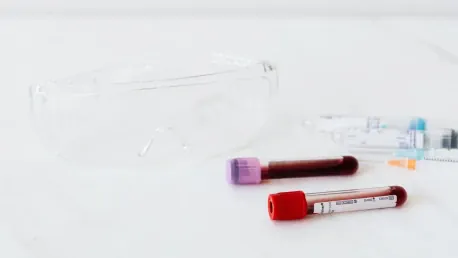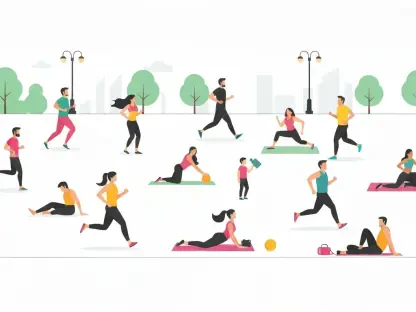The presence of microplastics (MPs) in human blood has become a pressing concern, with potential implications for health, particularly in relation to blood coagulation and inflammatory markers. This article delves into the prevalence of MPs in human biological systems, their sources, and the health risks they pose, based on recent research findings.
Prevalence of Microplastics in Human Environments
Global Plastic Production and Microplastic Formation
The massive increase in global plastic production since the mid-20th century has resulted in billions of tons of plastic waste, much of which degrades into microplastics (MPs). By 2021, over 390 million tons of plastic were produced annually, contributing to the proliferation of MPs, defined as plastic particles smaller than 5mm. These MPs can originate from either the degradation of larger plastic debris or from the manufacturing of small-sized plastics for specific uses. The ubiquitous presence of MPs in the environment means they are now found in a variety of consumer products and food items, significantly contributing to daily human exposure.
Research has shown that MPs are being incorporated into everyday materials and products, including textiles, packaging, and personal care items. As these products break down over time, they release MPs into the environment. The tiny particles can then contaminate soil and water, which ultimately leads to human exposure. MPs are resilient and persistent, making them an escalating concern for environmental and public health stakeholders globally. Addressing the challenge of MPs requires understanding their lifecycle, from production to decomposition, and their routes into human systems.
Pathways of Microplastic Exposure
Humans encounter microplastics through various pathways, primarily ingestion, inhalation, and dermal contact. MPs have been detected in an extensive array of food items, such as seafood, table salt, honey, and even drinking water, highlighting the pervasiveness of plastic pollution. The particles enter the food chain primarily through marine life that ingests plastic debris, which then makes its way onto our plates. Additionally, MPs are present in the air, especially in urban environments where the density of plastic pollution is highest, leading to inhalation of these particles. This inhalation is a growing concern, particularly given the potential for MPs to affect respiratory health.
Dermal exposure occurs through the use of personal care products that contain microbeads and other plastic particles. These products, including exfoliants, soaps, and toothpaste, contribute to the deposition of MPs on the skin. While the full impact of skin absorption of MPs remains under scrutiny, initial findings suggest potential infiltration through cuts and abrasions. The pervasive use of everyday plastics and the incomplete knowledge of the lifespan of MPs emphasize the urgent need to better understand the mechanisms and health impacts of this exposure.
Detection of Microplastics in Human Blood
Study Overview and Participant Demographics
A groundbreaking study aiming to uncover the presence of microplastics in human blood and explore potential health effects recruited 36 healthy Korean adults. The study’s main goal was to detect the presence of MP particles in the blood and gauge their concentrations. Astonishingly, MPs were found in 32 out of the 36 blood samples analyzed, with the average concentration measuring 4.2 particles per milliliter. The sizes of these MPs ranged predominantly from 20 to 50 μm, with fragments being more common than fibrous forms. This data underscores the widespread prevalence of MPs in human biosystems, raising alarms about possible health consequences.
The researchers used sophisticated techniques to identify and quantify MP particles, ensuring the accuracy and reliability of their findings. This study sheds light on the omnipresence of MPs in daily human activities, contributing to their infiltration into the human circulatory system. The findings also suggest that regardless of the population’s health status, there is an underlying issue of microplastic contamination that permeates human biological systems. Further demographic data revealed interesting patterns in MP prevalence related to various lifestyle and environmental factors.
Correlation with Lifestyle Factors
The study evaluated the relationship between lifestyle factors and the concentrations of microplastics found in participants’ blood. One significant finding was the correlation between plastic container usage and higher levels of MPs. Participants who used plastic containers for more than 50% of their food storage had an MP concentration of 6.8 particles per milliliter in their blood, in stark contrast to 2.4 particles per milliliter in those who used fewer plastic containers. This finding implies that everyday plastic use directly contributes to microplastic deposition within the human body, emphasizing the role of lifestyle choices in determining the extent of MP exposure.
Other lifestyle factors examined included dietary habits, frequency of seafood consumption, and the use of personal care products containing microbeads. The comprehensive analysis brought to light that individuals with higher consumption rates of such products also showed elevated MP levels. These results advocate for a deeper investigation into lifestyle practices and their ties to microplastic exposure, offering pathways for reducing internal MP loads through conscious consumption decisions. The study also highlighted the importance of public awareness regarding the impact of everyday plastic use on health and well-being.
Impact on Blood Coagulation Markers
Coagulation Pathways and Microplastic Exposure
Emerging research suggests that the presence of MPs in the bloodstream can disrupt normal blood coagulation pathways, posing significant cardiovascular health risks. The study’s analyses showed that participants with higher concentrations of MPs in their blood exhibited prolonged activated partial thromboplastin time (aPTT). This finding indicates that MPs might interfere with the clotting process, leading to potential bleeding disorders or other coagulation-related health issues. Prolongation of aPTT suggests alterations in coagulation pathways, which can have profound implications for the body’s ability to manage bleeding and clotting effectively.
In particular, the study pointed out the adverse effect MPs could have on intrinsic coagulation pathways. Intrinsic pathways are responsible for maintaining hemostasis by balancing bleeding and clotting, and any disruption can result in severe health implications. MPs may introduce foreign substances that disrupt this balance, making blood less or more likely to clot than normal. This disruption raises concerns about the increased risk of hemorrhage or thrombosis (blood clots), both of which can have fatal outcomes if not properly managed.
Inflammatory Markers and Cardiovascular Risks
An additional significant finding from the study was the heightened levels of inflammatory markers, such as C-reactive protein (CRP), in participants with higher MP concentrations. Elevated CRP levels are indicative of inflammation within the body, which is a precursor to various cardiovascular diseases. The inflammatory response suggests that MPs might trigger adverse immune reactions, exacerbating inflammation and leading to chronic health conditions. Further, participants with higher MP levels also displayed increased fibrinogen levels, a protein critical to blood clot formation. Elevated fibrinogen levels can indicate a higher risk of blood clots, posing additional threats to cardiovascular health.
The study’s findings demonstrated a clear link between MP exposure and heightened cardiovascular risk factors. It highlighted the plausible role MPs play in promoting a pro-inflammatory state within the body, further contributing to the development of cardiovascular diseases. The potential toxicity and the role of MPs in vascular inflammation must be thoroughly explored in future studies, as this can inform the creation of health guidelines and mitigation strategies. The findings call attention to the broader implications of environmental pollutants like MPs, as their impact extends beyond immediate health effects to long-term disease progression.
Health Implications and Future Research
Potential Health Risks
The study underscores the broad and potentially severe health risks associated with chronic exposure to microplastics, particularly through mechanisms such as inflammation and coagulation disturbances. The detected correlations between higher MP concentrations and increased levels of inflammatory and coagulation markers signify a worrying trend, as these markers are well-known predictors of cardiovascular diseases. Continued exposure to MPs could potentially heighten the risk of developing conditions like atherosclerosis, hypertension, and other inflammatory-related diseases, emphasizing the need for public awareness and remedial actions.
Moreover, the potential for MPs to serve as vectors for other harmful substances, including heavy metals and persistent organic pollutants, further amplifies their threat. This dual exposure could exacerbate health risks, underscoring the complex and multifaceted nature of MP-related health impacts. Addressing these risks involves a concerted effort towards understanding the broader health implications, necessitating robust scientific inquiry and interdisciplinary collaboration. Regular monitoring and reporting on MP exposure levels and associated health outcomes will be vital in developing effective public health responses.
Need for Further Research
While the findings of this study offer vital insights into the adverse health impacts of MPs, they also underline the imperative need for further research. The study’s relatively small sample size limits the generalizability of its findings, and potential contamination risks during the study highlight the necessity for more stringent research methodologies. Future studies should involve larger, more diverse populations to ascertain the prevalence of MPs across various demographics and geographies. Additionally, employing advanced analytical techniques will improve the accuracy and reliability of MP detection in biological samples.
Further research should also aim to elucidate the specific mechanisms through which MPs affect health, particularly focusing on their interaction with cellular and molecular processes. Understanding these mechanisms will be crucial in developing targeted interventions and guiding regulatory standards. Moreover, longitudinal studies tracking MP exposure over time will provide comprehensive data on the long-term health implications, contributing to a holistic understanding of MP-related health effects. Interdisciplinary efforts merging environmental science, toxicology, and public health will be essential to tackling the complexities posed by MP exposure.
Mitigation Strategies and Public Health Interventions
Reducing Microplastic Exposure
To effectively address the health risks associated with MPs, comprehensive strategies to minimize exposure are paramount. Simple everyday changes, like reducing the use of plastic containers and opting for safer alternatives such as glass or stainless steel, can markedly decrease MP exposure. Encouraging public awareness about the sources of MPs through education campaigns can empower individuals to make informed choices that mitigate their risk. Emphasizing the benefits of reducing plastic use and promoting sustainable practices will contribute significantly to safeguarding public health.
Additionally, innovative approaches in product design and material science can play a crucial role in reducing MP prevalence. For instance, developing biodegradable or non-plastic alternatives for consumer products can reduce the introduction of MPs into the environment. Organizations and industries must also take responsibility by implementing practices that limit plastic pollution at the source. These cumulative efforts, reinforcing a shift towards more sustainable lifestyles, will be critical in mitigating the potential hazards posed by MPs.
Policy and Regulatory Measures
Beyond individual actions, systemic changes driven by robust policies and regulations are essential to address the MP challenge at a broader scale. Governments and regulatory authorities need to enforce measures that reduce plastic production, encourage recycling, and restrict the use of harmful plastics in manufacturing. Policies aimed at decreasing single-use plastics and promoting eco-friendly alternatives can significantly impact the amount of plastic waste entering the environment. Regulatory measures should also aim to phase out microbeads in personal care products and other sources of MPs to further reduce human exposure.
Collaborative global efforts are necessary to tackle the transboundary nature of plastic pollution. Multilateral agreements and partnerships focusing on reducing plastic waste can create a unified approach to managing MPs. Comprehensive regulations, combined with public and private sector initiatives, can drive significant progress in reducing MP prevalence and its associated health risks. Effective policy implementation, regular monitoring, and adaptive strategies will ensure sustained efforts toward mitigating MP exposure, ultimately protecting human health and the environment.
Conclusion
The presence of microplastics (MPs) in human blood has emerged as a significant health concern, with possible impacts on bodily functions, particularly regarding blood coagulation and inflammatory markers. Recent research has brought to light the wide prevalence of MPs in human biological systems. These tiny plastic particles are found not just in oceans and soil but have made their way into the bloodstream of people. Sources of MPs include everyday items like packaging, cosmetics, and even the air we breathe. The health risks they pose are becoming increasingly apparent as new studies indicate that MPs can interfere with normal cellular functions, potentially leading to a range of health issues. This article explores the origins of these particles, how they infiltrate human systems, and what science currently understands about their impact on overall health. By examining the latest research findings, a clearer picture emerges of the dangers associated with MPs and underscores the need for continued investigation and potential regulatory measures to protect public health.









